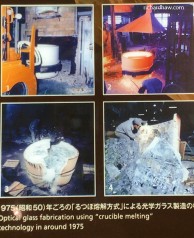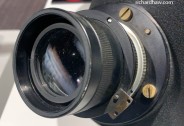Hello, everybody! I am going to begin a new series in this article and I am going to report on the current exhibit at the Nikon Museum which they call the “Special Collection“. It’s a very interesting exhibit showcasing some of Nikon’s more unusual creations that’s made for scientific, military, medical and other fields where specialized optics are needed. This is something that every serious Nikon fan should take part in and I will cover it for you if you cannot make it to the museum. If you can travel to Tokyo then please do so while this is still up and I am sure that it’s going to be worth your time. Please enjoy this report.
 Nikon has a long history of making special optics such as this big thing, a telescope used for observing the night sky. This is one of the smaller ones and the ones at the picture at the back are its bigger siblings that are too big to fit the museum. This one is not part of the exhibit, it’s been in this spot for as long as I can remember but it fits the theme.
Nikon has a long history of making special optics such as this big thing, a telescope used for observing the night sky. This is one of the smaller ones and the ones at the picture at the back are its bigger siblings that are too big to fit the museum. This one is not part of the exhibit, it’s been in this spot for as long as I can remember but it fits the theme.
Glass Manufacturing:
Nikon is primarily an optics company and its old name of Nippon Kogaku literally means Japanese Optics. Obviously, you can’t have optics without glass so Nikon prides in making their own glass. If I am not mistaken there are only a few manufacturers that make their own glass, one is Nikon and another one is Zeiss. Sure, Tokina is part of the TKH (Tokina, Kenko, Hoya) group and Hoya supplies optical glass to other manufacturers (like Sigma) but they’re still technically 2 separate entities. Making your own glass has its advantage – you can design lenses exactly to your own specifications and not to what is available to you that’s dictated by what your supplier has. Nikon was forced to make their own glass for lenses after the war because their stock of exotic German glass was running out so they had to make their own to keep their business going. They were actually doing this as early as 1918 but I’m not sure if Nikon had the ability to make exotic glass before the war.
 Here’s the small exhibit that shows the different optical glass types that Nikon makes. It’s just a simple presentation and the actual process and variety should be more extensive.
Here’s the small exhibit that shows the different optical glass types that Nikon makes. It’s just a simple presentation and the actual process and variety should be more extensive.
(Click to enlarge)
Here’s a closer look at the literature. It shows the history of glass manufacturing at Nikon and a simple illustration of the processes involved in the crucible-melting method. This is the old way of making optical glass where you pour molten glass into a crucible or mold. You then break the crucible once the glass has cooled to get what’s inside of it. It’s a very inefficient way of making glass and your yield can’t be uniform across every batch. This is why Nikon used and improved the alternative manufacturing process to improve their production efficiency. The crucible method isn’t what I’d call efficient, we use that same method for manufacturing jewelry and dentures. A mold has to be made and destroyed each time, this is tedious and you will soon get tired of it.
(Click to enlarge)
Here are some of the pictures showing the types of optical glass that Nikon makes along with simple descriptions to show what’s special about them.
Fundus Camera:
Nikon has been involved in the medical field since its early years and they made special equipment that’s exclusive for certain use and one of them is the fundus camera. What’s a fundus camera? Well, an eye fundus is the opposite wall to the pupil and it requires a special setup to photograph because it’s situated deep-inside the eyeball. Nikon made this small-type fundus camera specially for that. It’s basically a modified Nikon F with special attachments such as a lens, trigger, flash and its own pwer supply. This makes the whole business of documenting a patient’s eye simpler and cheaper. There are many small-type of fundus cameras in recent years but the ones made several decades ago were big so the one Nikon made is more convenient despite having the need for its own power supply.
(Click to enlarge)
Here’s a picture of the special fundus camera and a short description of it.
 This is its special power supply. The whole setup is useless without this thing. This is the same concept as the Medical-Nikkor kits which also requires their own power supply to operate properly.
This is its special power supply. The whole setup is useless without this thing. This is the same concept as the Medical-Nikkor kits which also requires their own power supply to operate properly.
(Click to enlarge)
Here’s some pictures showing the details of the fundus camera and how it’s used. Funny that the dummy is aiming at the forehead but you should get the idea. If this is used for researching about male pattern baldness then I am very interested.
Astro Camera:
This is a special camera for astrophotography and it uses the larger medium-format film size for a more “panoramic” ratio. I imagine that this was made so a more portable setup (with special lens) can be used for documenting the night skies. Just like all larger setups it has a lens shutter exployed to make things smaller. This is also ideal because it has less vibration since a lens shutter mechanism works like an iris in principle. You will require a sturdy tripod for this thing and use a separate finder to frame your shot. It’s interesting that it comes with a focusing ring, something that’s pointless but what do I know?
(Click to enlarge)
Here’s the camera and a short description about it. I was hoping to read more but this is all there is. It would be nice to read about its use and what made it so special.
(Click to enlarge)
Here are some more pictures of the camera showing the details of the shutter. It’s like a simple Seiko shutter from the looks of it but we won’t know unless we open it. I don’t see why Nikon would develop a special shutter for this as they have a working relationship with Seiko and their shutters are very reliable and cheap.
Fisheye Nikkor 19.3mm f/3.5:
This one is the most unusual one for part 1 because you will need a whole set to make it work for ints intended use. It’s not a stand-alone unit and is just a part of a while unit. It’s one of the rarest exhibits in the museum and I wish that it comes with the rest of the set.
(Click to enlarge)
Click on the pictures to read what this lens is for and see the unique wagon that the lens and its siblings are supposed to be attached to. I imagine that this is an expensive project, something that you just can’t use for a single event and then moth-ball it for eternity so I suspect that this has been used for other things other than what the poster mentioned.
 Just look at the size of that thing! It’s not as wide as many fisheye lenses but I am sure it’s for a good reason, maybe this lens has less geometric distortion or other properties when compared to the usual fisheye lens. I’m thinking that since you need an array of 5 lenses to complete a (hemispherical) projection then you don’t need such a wide coverage from a single lens since the others can help fill-the-gaps. I wonder how they stitched the final movie to appear seamless if that’s even possible. It must be a pain to align and calibrate a whole array of projections just so that every star at the seams line-up.
Just look at the size of that thing! It’s not as wide as many fisheye lenses but I am sure it’s for a good reason, maybe this lens has less geometric distortion or other properties when compared to the usual fisheye lens. I’m thinking that since you need an array of 5 lenses to complete a (hemispherical) projection then you don’t need such a wide coverage from a single lens since the others can help fill-the-gaps. I wonder how they stitched the final movie to appear seamless if that’s even possible. It must be a pain to align and calibrate a whole array of projections just so that every star at the seams line-up.
(Click to enlarge)
Here are some close-ups of the engravings for those who are keen on documenting it. It’s huge and you will definitely need special tools to open or seal this thing.
(Click to enlarge)
Here’s some pictures of the back of the thing. It has an aperture ring but you cannot find any focusing ring since it would be impractical. The focus is probably permanently-fixed to infinity since it’s intended to shoot the night sky anyway. A focusing ring can be a bad idea because it can be knocked and turned to focus at another distance. This is not made to be shot with a camera so I don’t know what mount it comes with. The die-cast housing looks nice, something that you don’t see anymore these days.
That’s all for part 1, please come back for more on this series and I will try to update this as quick as I can. I am busy these days so I am using my precious vacation time to update the blog. See you guys again in the next article, Ric.
Help Support this Blog:
Maintaining this blog requires money to operate. If you think that this site has helped you or you want to show your support by helping with the upkeep of this site, you can simple make a small donation to my paypal.com account (richardHaw888@gmail.com). Money is not my prime motivation for this blog and I believe that I have enough to run this but you can help me make this site (and the companion facebook page) grow.
Leave me some tip?
Thank you very much for your continued support!
$2.00
Helping support this site will ensure that this will be kept going as long as I have the time and energy for this. I would appreciate it if you just leave out your name or details like your country and other information so that the donations will totally be anonymous it is at all possible. This is a labor of love and I intend to keep it that way for as long as I can. Ric.































May 07, 2019 @ 20:00:59
Looking forward to what looks like an underwater housing in that collage.